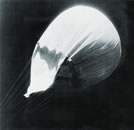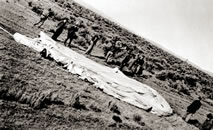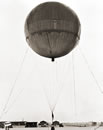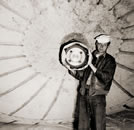Giant gas-filled paper globes drifted serenely across the Pacific in 1945, on their way to terrorize the United States with random bomb strikes.
By Bruce Heydt
A few months earlier, a similar device had been discovered near Kalispell, Montana. Had Mrs. Mitchell known about that incident, she might have been more cautious. But the Federal Bureau of Investigation had covered up the news for a few weeks. When the bureau finally lifted its fog, the story went public in a brief buried in the January 1, 1945, issue of Newsweek. Most Americans never noticed it. Under the heading “Balloon Mystery,” the magazine reported: In a snow-covered, heavily forested area southwest of the Montana town, two woodchoppers found a balloon with Japanese markings on it. Made of processed paper, the 33 1/2-foot bag bore on its side a small incendiary bomb, apparently designed to explode and prevent seizure of the balloon intact. Also attached were 45-foot rope cables, roughly hacked as if to show that the balloon’s gondola had been purposely severed. Some of the suppositions about the mystery balloon would eventually prove wrong. In fact, the unnamed Newsweek reporter admitted the discovery raised more questions than could then be answered. Had the balloon carried any passengers? If so, where were they? Where were the parachutes or the gondola by which they might have descended? Had the balloon come from an enemy submarine operating off the West Coast, or had it been flown all the way from Japan? The War Department continued to reassess the danger as more facts surfaced. “The Japanese have for some time been sending over unmanned balloons, carrying explosives, to land in western North America,” it announced at one point. “Though no property damage had been done, there was such a chance of personal danger to unsuspecting civilians that the War and Navy Departments felt compelled to warn the public.” The use of such an unlikely method for carrying the war to the American mainland revealed how desperately wartime Japan craved to strike her enemy’s home. The balloon bombs clearly had limited, if any, strategic value. Prior to December 7, 1941, the prevailing wisdom among the Japanese had held that no American bomb would ever fall on their sacred soil. The Doolittle Raid on Tokyo on April 18, 1942, dispelled that prewar hubris. In an attack that had mostly symbolic value, Lieutenant Colonel James Doolittle’s squadron of 16 B-25B medium bombers had peppered Tokyo with 16 tons of bombs—a very modest effort that led Japanese punsters with a grasp of the English language to dub it the Do-Nothing Raid. As the war rolled on into 1943 and beyond, however, the Japanese home islands became ever more vulnerable. The fall of the islands Tinian, Saipan, and Guam in 1944 ultimately brought Japan within range of American B-29 heavy bombers, which was no laughing matter. Japan kept trying to develop a conventional attack aircraft capable of taking the war from within its shrinking empire to the American homeland, but failed. Nevertheless, national morale and honor required retaliation for the American bomb raids, even if it meant turning to unconventional means. Back in the 1930s, the Japanese Military Scientific Laboratory had conceived of an unmanned, lighter-than-air balloon that would carry a bomb. With a range of only about 70 miles, however, the weapon officially designated Fu-Go (“wind-ship weapon” or “balloon weapon”) offered little potential for use against an offshore enemy. The Fu-Go never went into production, but the idea of balloon-borne bombs never entirely faded. Hydrogen expands at higher daytime temperatures, thereby increasing a balloon’s buoyancy but also raising the pressure inside it. To keep their balloons from bursting, the Japanese designers engineered a release valve to bleed off hydrogen when pressure exceeded a preset limit or when a balloon ascended above 38,000 feet. The loss of gas would reduce buoyancy and cause the balloon to descend to a safer altitude. Conversely, when lower nighttime temperatures cooled the hydrogen and the pressure dropped below a certain level—or whenever a balloon dropped below about 29,500 feet—an altimeter would activate a mechanism to release a pair of the 32 sandbags the typical balloon carried. Thus lightened, the balloon would slowly ascend. By means of these automatic devices, the balloon bombs would bob up and down in the atmosphere within a fairly regular range of altitudes throughout their flights. A balloon bomb would carry enough ballast for a three-day flight, by which time it should have arrived over America. By then, with less hydrogen left to keep it aloft, the balloon would start descending, especially when exposed to coolness. But having already released all its ballast, it would no longer be able to rise by dropping weight, and would soon sink below 27,000 feet. When this happened, the two incendiary bombs and single anti-personnel bomb it carried would be released. Finally, a fuse would ignite and burn for about 80 minutes before setting off a gunpowder charge to destroy the balloon, keeping its secrets out of American hands. In 1944 an army officer from the military arsenal in Kokura on Kyushu came to our school and told us that we would be making a “secret weapon.” The weapon would have a great impact on the war. He didn’t say then that we would be making balloon bombs, only that somehow what we made would fly to America. A factory started at our school in August 1944. Stands were placed all over the schoolyard and drying boards were erected on them…. We covered the board with a thin layer of paste…and then laid down two sheets of Japanese paper and brushed out any bubbles. When dry, a thicker layer of paste, with a slightly bluish hue, a little like the color of the sky, was evenly applied to it. That process was repeated five times. We really believed we were doing secret work, so I didn’t talk about this even at home, but my clothes were covered with paste, so my family must have been able to figure out something. Despite what Tanaka was told, it seems evident that this so-called secret project was never intended to be truly covert, but was rather a scheme designed primarily to boost Japanese civilian morale by making the people believe they were playing an active role in defeating the enemy. If Doolittle’s 1942 attack drew derision as the Do-Nothing Raid, the Japanese counterpunch only paled by comparison. Japanese officials interviewed after the war revealed that their hope had been that Tanaka and her peers in several other schools who were drafted into the program would produce upwards of 120,000 balloons for the military to set adrift in the jet stream. By war’s end, however, only 9,000 had been launched. Historian Mikesh’s study of official reports yielded 285 documented incidents involving balloon bombs over North America, including a handful as far east as Iowa. Almost all the reports involved nothing more than the discovery of fragments of balloons, ballasts, valves, and other pieces, including quite a few unexploded bombs. Several reported incidents ended with one or more balloons being shot down. Given the fragmentary nature of most of the discovered wreckage, it’s reasonable to assume that many of the findings were the scattered remains of a single balloon. All this considered, it’s likely that about 200 to 250 balloons actually passed over the West Coast and continued eastward. That many balloons would have carried a rough total of 11 tons of explosives—two-thirds of the weight the Doolittle raiders dropped on Tokyo. The damage caused by those payloads, though, bears no comparison. The only known casualties caused by the balloon offensive were the six picnickers on Pastor Mitchell’s ill-fated outing. A few small fires were started in the forests of the Pacific Northwest, but there was no significant damage. For Tanaka Tetsuko, who had once been so proud to serve her country as a member of the Student Special Attack Force, discovering the truth of the balloon bomb project put a shameful twist on the memories of her unusual schoolyard adventure. “We only learned some forty years later that the balloon bombs we made had actually reached America,” she said. “They started a few forest fires and inflicted some casualties, among them children. Five children and a woman on a picnic in Oregon in May 1945 when a bomb dropped earlier exploded. When I heard that, I was stunned. I made those weapons…. Some of us got together and felt we would like to organize an effort to apologize. I started with my classmates, but encountered strong resistance….” Compared with the horrors wrought by more effective methods of warfare, Tanaka found, most people figured that apologizing for something as trivial as this was unwarranted. Though some Japanese did travel to the United States in later years to apologize for the balloon bombings, most wanted simply to forget. And as time went on, they pretty much did. On both sides of the Pacific, the former enemies moved on, and one of the war’s stranger offensives became an obscure, if remarkable, piece of historical trivia. Copyright 310 Publishing, LLC. All rights reserved. 
 Answers to all these questions became tragically apparent in the months that followed. When Mrs. Mitchell and the five children were killed in Oregon, the War Department clamped a lid on the story while it assessed how much of a threat the balloon bombs really were. But with the approach of summer and the likelihood that schoolchildren enjoying their summer vacations would soon be flocking to parks and other outdoor recreational spots up and down the West Coast, the department finally gave the okay for Pastor Mitchell to talk about his horrific experience as a warning to others who might accidentally stumble across a similar device.
Answers to all these questions became tragically apparent in the months that followed. When Mrs. Mitchell and the five children were killed in Oregon, the War Department clamped a lid on the story while it assessed how much of a threat the balloon bombs really were. But with the approach of summer and the likelihood that schoolchildren enjoying their summer vacations would soon be flocking to parks and other outdoor recreational spots up and down the West Coast, the department finally gave the okay for Pastor Mitchell to talk about his horrific experience as a warning to others who might accidentally stumble across a similar device. Military aviation historian Robert C. Mikesh writes that, as early as 1942 (which again suggests a reaction to the Doolittle Raid), the Japanese began investigating the practicality of using the prevailing westerly winds over the northern Pacific Ocean to carry unmanned balloons all the way to North America. In his book Japan’s World War II Balloon Bomb Attacks on North America, Mikesh reports that the Japanese found that a balloon would probably cover the 6,200-mile distance to the West Coast of North America in 50 to 70 hours when released at a high altitude over Japan. But along the way it would face variable air pressures and temperatures that could destroy it.
Military aviation historian Robert C. Mikesh writes that, as early as 1942 (which again suggests a reaction to the Doolittle Raid), the Japanese began investigating the practicality of using the prevailing westerly winds over the northern Pacific Ocean to carry unmanned balloons all the way to North America. In his book Japan’s World War II Balloon Bomb Attacks on North America, Mikesh reports that the Japanese found that a balloon would probably cover the 6,200-mile distance to the West Coast of North America in 50 to 70 hours when released at a high altitude over Japan. But along the way it would face variable air pressures and temperatures that could destroy it. Unlike the secret weapon the United States was developing—the atomic bomb—the balloon bomb was a low-tech solution that depended on no major technological breakthroughs or sophisticated manufacturing infrastructure. It was a simple weapon for a nation whose industry was already under continual attack. In fact, once the basic design had been hammered out, the balloons themselves were manufactured not by research scientists but by Japanese schoolchildren. One of these was 15-year-old Tanaka Tetsuko, a student in Yamaguchi Girls’ High School. Tanaka, part of the so-called Student Special Attack Force, told her story of making balloon bombs to Haruko Taya Cook and Theodore Cook for their book Japan at War: An Oral History:
Unlike the secret weapon the United States was developing—the atomic bomb—the balloon bomb was a low-tech solution that depended on no major technological breakthroughs or sophisticated manufacturing infrastructure. It was a simple weapon for a nation whose industry was already under continual attack. In fact, once the basic design had been hammered out, the balloons themselves were manufactured not by research scientists but by Japanese schoolchildren. One of these was 15-year-old Tanaka Tetsuko, a student in Yamaguchi Girls’ High School. Tanaka, part of the so-called Student Special Attack Force, told her story of making balloon bombs to Haruko Taya Cook and Theodore Cook for their book Japan at War: An Oral History: The fate of most of these devices is uncertain. Many carried radio transmitters so their progress across the ocean could be tracked, but the information collected was ambiguous. A loss of signal could mean a balloon had successfully delivered its payload and then self-destructed or that it had lost pressure and slowly descended into the ocean—or that it had been intercepted and shot down. US press reports of landings could have helped the tracking effort, but the War Department censored that information so the Japanese could not easily obtain a running count of how many balloons reached the States. The censorship also deprived the Japanese of details that might have allowed them to refine their balloon operations.
The fate of most of these devices is uncertain. Many carried radio transmitters so their progress across the ocean could be tracked, but the information collected was ambiguous. A loss of signal could mean a balloon had successfully delivered its payload and then self-destructed or that it had lost pressure and slowly descended into the ocean—or that it had been intercepted and shot down. US press reports of landings could have helped the tracking effort, but the War Department censored that information so the Japanese could not easily obtain a running count of how many balloons reached the States. The censorship also deprived the Japanese of details that might have allowed them to refine their balloon operations.


FOLLOW US »
